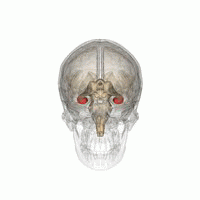
Photo from wikipedia
Learning and memory are linked to dynamic changes at the level of synapses in brain areas that are involved in cognitive tasks. For example, changes in neurotransmitter receptors are prerequisite… Click to show full abstract
Learning and memory are linked to dynamic changes at the level of synapses in brain areas that are involved in cognitive tasks. For example, changes in neurotransmitter receptors are prerequisite for tuning signals along local circuits and long-range networks. However, it is still unclear how a series of learning events promotes plasticity within the system of neurotransmitter receptors and their subunits to shape information processing at the neuronal level. Therefore, we investigated the expression of different glutamatergic NMDA (GRIN) and AMPA (GRIA) receptor subunits, the GABAergic GABARG2 subunit, dopaminergic DRD1, serotonergic 5HTR1A and noradrenergic ADRA1A receptors in the pigeon’s brain. We studied the nidopallium caudolaterale, the avian analogue of the prefrontal cortex, and the hippocampal formation, after training the birds in a rewarded stimulus-response association (SR) task and in a simultaneous-matching-to-sample (SMTS) task. The results show that receptor expression changed differentially after behavioral training compared to an untrained control group. In the nidopallium caudolaterale, GRIN2B, GRIA3, GRIA4, DRD1D, and ADRA1A receptor expression was altered after SR training and remained constantly decreased after the SMTS training protocol, while GRIA2 and DRD1A decreased only under the SR condition. In the hippocampal formation, GRIN2B decreased and GABARG2 receptor expression increased after SR training. After SMTS sessions, GRIN2B remained decreased, GABARG2 remained increased if compared to the control group. None of the investigated receptors differed directly between both conditions, although differentially altered. The changes in both regions mostly occur in favor of the stimulus response task. Thus, the present data provide evidence that neurotransmitter receptor expression dynamics play a role in the avian prefrontal cortex and the hippocampal formation for behavioral training and is uniquely, regionally and functionally associated to cognitive processes including learning and memory.
Journal Title: Frontiers in Physiology
Year Published: 2022
Link to full text (if available)
Share on Social Media: Sign Up to like & get
recommendations!